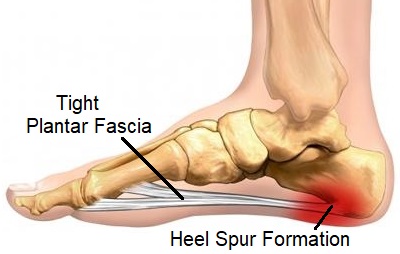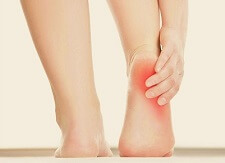- Home
- Common Foot Problems
- Bone Spurs
Foot & Heel Bone Spurs
Written By: Chloe Wilson BSc(Hons) Physiotherapy
Reviewed By: FPE Medical Review Board
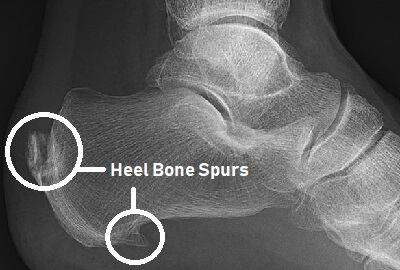
Heel bone spurs are areas where excess bone has grown on the heel, forming a hard lump.
Heel spurs are also referred to as osteophytes or calcaneal spurs and can vary greatly in size.
Heel spurs usually form on the back of the heel or directly underneath it. They develop in response to irritation of the bone either from inflammation, repetitive friction, or following an injury.
Women have a much higher incidence of foot bone spurs due to frequent wear of tight-fitting shoes with high heels or pointed toes.
Here, we will look at the common causes, locations and symptoms of foot and heel bone spurs. We will then go on to look at the different treatment options.
What Causes Heel Bone Spurs?
Bone spurs are caused by abnormal bone growth. When there is constant irritation or stress on a bone, the cells responsible for bone growth are stimulated to produce excess calcium deposits to try and protect the bone from injury. As the calcium deposit layers build up, a spur-shaped deformity forms.
The most common reasons heel bone spurs develop are:
- Soft Tissue Tension: Tightness in soft tissues such as ligaments, muscles and tendons is a common cause of heel bone spurs. The tight soft tissue pulls on the part of the bone that it is attached too, causing excessive tension and local inflammation. Plantar fascia tightness and calf/achilles tightness are common causes of heel bone spurs
- Footwear: Wearing shoes that are too tight, unsupportive or the wrong shape place repetitive friction on parts of the foot. This commonly results in bone spurs on the back of heel
- Injury: anything from minor bruising to a fracture of the bone can lead to the laying down of excess calcium deposits as part of the healing process. This is a good response to the problem initially, but if it continues too long, heel spurs can develop
- Inflammation: When a joint is inflamed due to chronic conditions such as rheumatoid arthritis or ankylosing spondylitis the constant irritation can lead to bone spurs
- Exercise: Repetitive activities such as running and jumping especially on hard surfaces can cause osteophyte formation on the heel bone
- Abnormal Foot Biomechanics: A problem in the way the foot bones sit and move, such as reduced arch height aka flat feet, can place excess pressure on certain areas of bone leading to the formation of heel bone spurs
- Aging: As we age, the soft cartilage that lines our joints can start to degenerate. This places more pressure and friction through the bones which can lead to the formation of spurs. Bone spurs related to ageing are most commonly found in the spine or the feet
Where Do Heel Spurs Develop?
Foot spurs can develop on any of the foot bones, but the most common place to get them is on the heel bone, the calcaneus. These are known as calcaneal spurs. Heel bone spurs usually occur in one of two places:
1. Inferior Calcaneal Spur
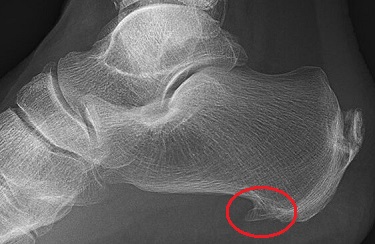
Inferior calcaneal spurs are located underneath the heel bone.
They are usually associated with a tight plantar fascia and Plantar Fasciitis but can also be linked with ankylosing spondylitis or altered foot biomechanics.
You usually can’t see or feel inferior heel bone spurs as they are surrounded by soft tissue until they are quite large, but you may notice discomfort when you walk.
2. Posterior Calcaneal Spur
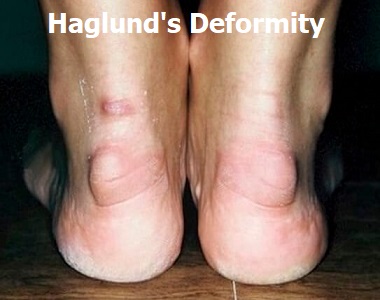
Posterior calcaneal spurs develop on the back of the heel, usually due to Achilles Tendonitis, calf muscle tightness or ill-fitting shoes.
You can usually see and feel a lump on the back of your heel, even when it is still small.
A posterior heel spur may also end up irritating the local bursa (fluid filled sac), a condition known as "Pump Bump" or Haglunds Deformity.
Heel Spur Symptoms
Common symptoms of heel bone spurs include:
- Sharp Pain: Sharp, stabbing pain, like standing on a pin. Heel bone spur pain tends to be worse after periods of rest, particularly first thing in the morning or after sitting for long periods. Morning foot pain from bone spurs can be quite intense, particularly the first few steps, but the pain usually starts to subside fairly quickly
- Dull Ache: Often with bone spurs, once you start walking around, the sharp pain settles, but then you are left with a dull, persistent ache
- Stiffness: The heel, ankle and calf region often feel stiff with bone spurs on initial movement, but this also settles as you get going
- Hard Lump: Depending on the size and the location of heel bone spurs you may feel a hard lump. Bone spurs are a common cause of foot lumps
- Numbness: If the heel spur is irritating one of the nearby nerves then there may be areas of numbness in the foot
- Corns & Calluses: Another common symptom is the formation of corns and calluses over the affected area. This is the bodies attempt to try and cushion the spur from above.
Often, there are no obvious symptoms from heel bone spurs unless they start rubbing on the surrounding tissues, such as muscles, nerves or other bones. Bone spurs are a common causes of foot pain in the morning.
#CommissionEarned from Amazon on qualifying purchases
How Do You Treat A Heel Spur?
Heel spur treatment usually comprises of:
- Exercises: Stretches and strengthening exercises to reduce the tension on the tendon, and strengthen the supporting muscles
- Orthotics: There are a number of different shoe inserts that can really help such as heel cups, arch supports and cushioning to correct the foot position and reduce friction over the bone spurs
- Medication: NSAID's to reduce pain and inflammation e.g. ibuprofen/Advil or naproxen
- Surgery: to remove the heel bone spur, sometimes combined with plantar fascia release
You can find out loads more about the different treatment options in the Heel Spur Treatment section.
Heel bone spurs are only treated if they are causing problems. If there is noticeable lump, but no pain or other symptoms, they will usually be left alone. If however they start to cause symptoms such as pain or numbness, or they are causing damage to surrounding structures, heel spur treatment is required.
Recovery Process
Ninety percent of people with heel bone spurs will recover within six to nine months with home treatment, depending on the size of the heel spur. The remaining 10% may require surgical intervention.
If you do require surgery, then rest assured, heel spur surgery is a relatively simple procedure. The recovery period varies depending on the type of surgery performed, but typically lasts 4-6 weeks. During this time, your doctor may recommend avoiding strenuous activities, wearing a special walking boot and then supportive shoes, and taking over-the-counter medications to ease pain and swelling. It may take up to 3 months to make a full recovery.
Your Questions Answered
Are Bone Spurs Serious?
Are Bone Spurs Serious?
Bone spurs themselves are not painful or dangerous but if they start encroaching on neighbouring structures like muscles, tendons, nerves or other bones, they can cause pain, stiffness and numbness.
Are Heel Spurs Permanent?
Are Heel Spurs Permanent?
The answer here is yes and no. Most heel spur symptoms will settle down with appropriate treatment such as physical therapy, exercises and orthotics. The lump however is unlikely to disappear completely on its own. Only about 10% of cases of heel spurs require surgery.
Can Heel Spurs Go Away On Their Own?
Can Heel Spurs Go Away On Their Own?
Unfortunately not. Without proper treatment, heel bone spurs are unlikely to settle, and if anything they will get worse. But with a course of physical therapy and simple exercises, most cases of heel spurs will resolve. The only way to permanently get rid of the hard lump from bone spurs is to have them surgically removed.
Is Walking Good For Heel Spurs?
Is Walking Good For Heel Spurs?
It is often very painful when you start walking with heel spurs, particularly first thing in the morning or after sitting for a while. But the good news is as you walk more, the pain does reduce as the tissues stretch out.
Do Heel Spurs Cause Other Problems?
Do Heel Spurs Cause Other Problems?
Heel bone spurs are often linked with other foot problems. Inferior heel spurs often go hand in hand with plantar fasciitis, and posterior heel spurs are often linked with achilles tendonitis and heel bursitis.
What Else Can Help?
Heel bone spurs are only one possible cause of heel pain. Other possibilities include heel bursitis, calcaneal fractures, tendonitis, plantar fasciitis and problems with the ankle bones. We look at all of these and more in the heel pain diagnosis section.
If you have a hard lump under your foot, it may actually be caused by something else e.g. plantar fibroma - check out the bump on bottom of foot article if you suspect it may be something other than heel bone spurs.
Or if you have a lump on the back of the heel that you suspect may not actually be a bone spur, check out the heel lumps article.
You may also be interested in the following articles:
- Foot Arch Pain
- Pain On Top Of Foot
- Nerve Pain In The Foot
- Burning Foot Pain
- Swollen Feet & Ankles
- Foot Numbness
- Foot Lumps & Bumps
Related Articles
Page Last Updated: 19th November, 2024
Next Review Due: 19th November, 2026
